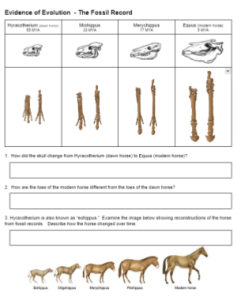
Evolution is considered the unifying theory of biology because it provides a comprehensive framework for understanding the diversity of life. The theory explains the similarities among organisms, and how organisms are related. The evidence for evolution is found in many disciplines, such as genetics and paleontology.
In this exercise, students explore the many lines of evidence that support the theory of evolution. Students can complete this exercise independently as part of a larger unit on evolution. I use the Miller and Levine Bee book, which places this unit at the end of semester two. Though many other books will place evolution at the beginning. You can find my complete curriculum at Biology 2 / 2A.
Ideally, I will introduce the concept of evolution starting with Darwin’s voyage. Students will understand that the finches he observed on the Galapagos descend from a common ancestor. They will also complete a virtual lab on Natural Selection that explores how environmental factors affect populations. If you have time, students can try other simulators the explore natural selection.
In the second section of the chapter, students explore evidence beyond Darwin’s observations that support the theory. The evidence for evolution encompasses many disciplines, so each section explores one aspect, such as the fossil record, or genetics.
The Evidence of Evolution Worksheet
Part 1: The Fossil Record
Examine skulls of extinct horses, such as Merychippus and compare those skulls to the modern horse. In addition, examine how the feet of horses change over time, where the modern horse walks on a single toe. Students will be able to describe how the horse changed over time. This evidence for evolution can be found throughout the fossil record.

Part 2: Embryology
Images of embryos show similarities between several vertebrate species, such as humans and chickens. Students identify features that the embryos all share in the early stages, such as gills and a tail.
Part 3: Comparative Anatomy
Students color the forelegs of several species (human, dog, bird, whale) so that each color is specific to the bone. They will see that each species has a humerus, radius, and ulna, though the shapes may differ. They will discuss how each bone is adapted for a specific function, such as swimming, grasping, running, and flying. Reveal homologous structures by coloring!
Part 4: Vestigial Structures
A whale skeleton shows the presence of tiny pelvic bones, even though whales do not have hind limbs. Students then suggest possible functions for other vestigial structures, like the tailbone, and the nictitating membrane of the eye.
Part 5: Molecular Biology
The amino acid sequence of Cytochrome C will show that related species have fewer differences in the sequences. Students highlight each difference and count the number compared to the human gene. Humans have the fewest cytochrome C differences with the monkey.
In the last section of the activity, students answer questions that help them to summarize the main lines of evidence for evolution.

